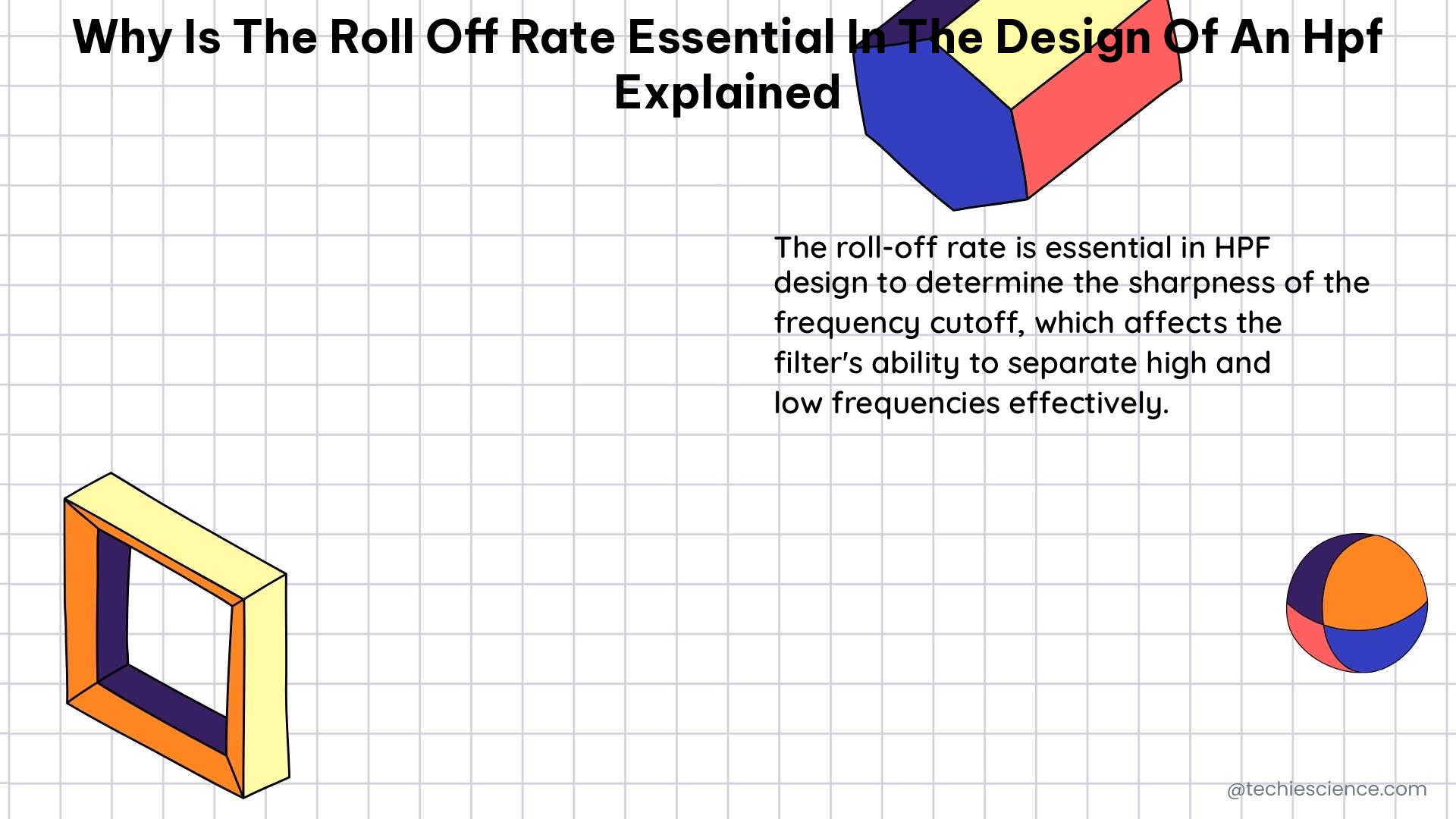The roll-off rate is a critical parameter in the design of high-pass filters (HPFs) because it determines the rate at which the filter attenuates signals below its cutoff frequency. A steeper roll-off rate means that the filter will more effectively block low-frequency signals, which is often desirable in many applications, such as audio processing, communication systems, and instrumentation.
Theoretical Explanation
The roll-off rate of a high-pass filter is determined by its order, which is the number of reactive elements (capacitors or inductors) in the filter circuit. The roll-off rate is typically measured in decibels per decade (dB/decade) or decibels per octave (dB/octave), and is given by the equation:
Roll-off rate (dB/decade) = 20 * n
where n is the filter’s order.
For example, a first-order HPF has a roll-off rate of -20 dB/decade, a second-order HPF has a roll-off rate of -40 dB/decade, and so on. This means that for every decade (factor of 10) decrease in frequency below the cutoff frequency, the filter’s attenuation increases by 20 dB, 40 dB, and so on, depending on the filter’s order.
The roll-off rate can also be expressed in terms of the filter’s transfer function, which is the ratio of the output signal to the input signal. For a high-pass filter, the transfer function is given by:
H(s) = 1 / (1 + s/ωc)
where s is the complex frequency, ωc is the cutoff frequency, and τ = 1/ωc is the time constant.
The roll-off rate can be determined from the transfer function by finding the magnitude of H(s) in decibels, which is given by:
|H(s)|dB = 20 * log10(|H(s)|)
For a high-pass filter, the magnitude of H(s) decreases as the frequency decreases below the cutoff frequency, and the rate of decrease is determined by the filter’s order.
Hands-On Details

To illustrate the importance of the roll-off rate in the design of high-pass filters, let’s consider a practical example. Suppose we want to design an HPF for a radio system that is intended to reject low-frequency interference. We need the filter to have a cutoff frequency of 100 kHz, and a roll-off rate of at least -40 dB/decade.
We can use a second-order HPF circuit, which consists of two capacitors and two resistors. The component values can be calculated using the following formulas:
C1 = 1 / (2 * π * R1 * fc)
C2 = C1
R2 = R1
where fc is the cutoff frequency, and R1 and C1 are the values of the first resistor and capacitor, respectively.
For our example, we can choose R1 = 1 kΩ and C1 = 159 pF, which gives us a cutoff frequency of 100 kHz and a roll-off rate of -40 dB/decade.
We can simulate the filter circuit using a circuit simulation software such as LTSpice or Qucs, and analyze its frequency response using the S-parameters or transient response analysis.
The S-parameters analysis will give us the filter’s frequency response in terms of its scattering parameters, which are measures of the filter’s input and output impedance, as well as its gain and phase shift. The transient response analysis will give us the filter’s step response, which can be used to determine the filter’s settling time, overshoot, and other transient characteristics.
By analyzing the frequency and transient responses of the filter circuit, we can verify that the filter meets the desired specifications, including the cutoff frequency and roll-off rate.
Technical Specification
The technical specification for a high-pass filter should include the following parameters:
| Parameter | Description |
|---|---|
| Cutoff frequency (fc) | The frequency at which the filter’s attenuation is 3 dB below its maximum value. |
| Roll-off rate (dB/decade or dB/octave) | The rate at which the filter’s attenuation increases as the frequency decreases below the cutoff frequency. |
| Passband ripple | The maximum variation in the filter’s gain within the passband. |
| Stopband attenuation | The minimum attenuation in the stopband. |
| Group delay | The time delay between the input and output signals, as a function of frequency. |
| Input and output impedance | The impedance of the filter’s input and output ports, respectively. |
| Power handling | The maximum power that the filter can handle without damage or performance degradation. |
| Operating temperature range | The range of temperatures over which the filter can operate without performance degradation. |
| Environmental conditions | The range of humidity, vibration, and other environmental factors that the filter can tolerate. |
Reference Links
- Marki Microwave: LC Filter Design Tool – https://markimicrowave.com/technical-resources/tools/lc-filter-design-tool/
- GWU SEAS: Chapter 16 – Active Filter Design Techniques – https://www2.seas.gwu.edu/~ece121/Spring-11/filterdesign.pdf
- Electronics Tutorials: Active High Pass Filter – https://www.electronics-tutorials.ws/filter/filter_6.html
- Nuts & Volts Magazine: Filter Basics: Stop, Block, and Roll(off) – https://www.nutsvolts.com/magazine/article/filter-basics-stop-block-and-rolloff

The lambdageeks.com Core SME Team is a group of experienced subject matter experts from diverse scientific and technical fields including Physics, Chemistry, Technology,Electronics & Electrical Engineering, Automotive, Mechanical Engineering. Our team collaborates to create high-quality, well-researched articles on a wide range of science and technology topics for the lambdageeks.com website.
All Our Senior SME are having more than 7 Years of experience in the respective fields . They are either Working Industry Professionals or assocaited With different Universities. Refer Our Authors Page to get to know About our Core SMEs.